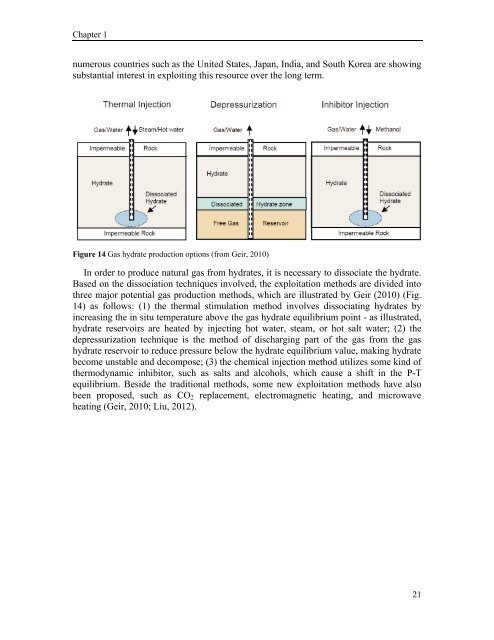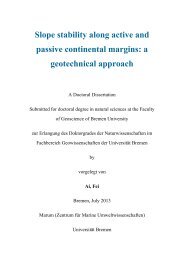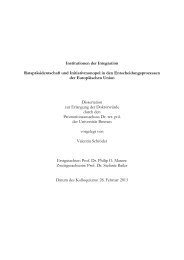Seismoacoustic Study of the Shallow Gas Transport and ... - E-LIB
Seismoacoustic Study of the Shallow Gas Transport and ... - E-LIB
Seismoacoustic Study of the Shallow Gas Transport and ... - E-LIB
Create successful ePaper yourself
Turn your PDF publications into a flip-book with our unique Google optimized e-Paper software.
Chapter 1<br />
numerous countries such as <strong>the</strong> United States, Japan, India, <strong>and</strong> South Korea are showing<br />
substantial interest in exploiting this resource over <strong>the</strong> long term.<br />
Figure 14 <strong>Gas</strong> hydrate production options (from Geir, 2010)<br />
In order to produce natural gas from hydrates, it is necessary to dissociate <strong>the</strong> hydrate.<br />
Based on <strong>the</strong> dissociation techniques involved, <strong>the</strong> exploitation methods are divided into<br />
three major potential gas production methods, which are illustrated by Geir (2010) (Fig.<br />
14) as follows: (1) <strong>the</strong> <strong>the</strong>rmal stimulation method involves dissociating hydrates by<br />
increasing <strong>the</strong> in situ temperature above <strong>the</strong> gas hydrate equilibrium point - as illustrated,<br />
hydrate reservoirs are heated by injecting hot water, steam, or hot salt water; (2) <strong>the</strong><br />
depressurization technique is <strong>the</strong> method <strong>of</strong> discharging part <strong>of</strong> <strong>the</strong> gas from <strong>the</strong> gas<br />
hydrate reservoir to reduce pressure below <strong>the</strong> hydrate equilibrium value, making hydrate<br />
become unstable <strong>and</strong> decompose; (3) <strong>the</strong> chemical injection method utilizes some kind <strong>of</strong><br />
<strong>the</strong>rmodynamic inhibitor, such as salts <strong>and</strong> alcohols, which cause a shift in <strong>the</strong> P-T<br />
equilibrium. Beside <strong>the</strong> traditional methods, some new exploitation methods have also<br />
been proposed, such as CO 2 replacement, electromagnetic heating, <strong>and</strong> microwave<br />
heating (Geir, 2010; Liu, 2012).<br />
21
















